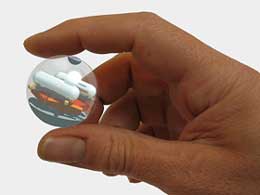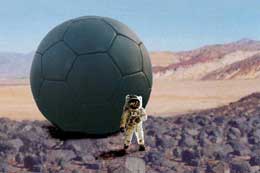Penelope Boston and Steven Dubowsky have received a grant from NASA Institute for Advanced Concepts to work on tiny hopping robots. An array of the microbots could be deployed on Mars, coordinating with one another like a swarm of insects to search for life below the surface of the planet.

The spheres would store up muscle energy, and then boink themselves off in various directions.
The researchers have calculated that about a thousand of the robots could be packed into a payload mass the size of one of the current Mars Exploration Rovers. That would give them the flexibility to suffer the loss of a large percentage of the units and still have a network that could be doing recon and sensing, imaging, and perhaps even some other science functions.
A fleet of these little spheres would be sent to some promising landing site, exiting from the lander and then making their way over to some subsurface or other hazardous terrain, where they deploy themselves as a network. They create a cellular communication network, on a node-to-node basis.
Some of the units could be fitted with magnification capability, so one could look at the textures of the materials that they are landing on. Some would also have chemical sensors to sniff and sense the chemical environment.
Via robots Universe Today.
Couldn’t help but think of this 2001 article about an inflatable, two-story tall beach ball. Equipped with scientific instruments, the “tumbleweed ball” conceived by JPL researchers could potentially explore vast tracts of Mars terrain, blown by the wind.

A scientific payload, carrying instruments such as magnetometers or water-seeking radar, would be held in place by tension cords at the tumbleweed’s center. Cameras mounted inside the ball would peer out at the local terrain. When scientists identify a promising spot and want the tumbleweed to put down roots and sit for a spell, the ball could be partially deflated. Then, when it’s time to move along again, the ball could be reinflated.







